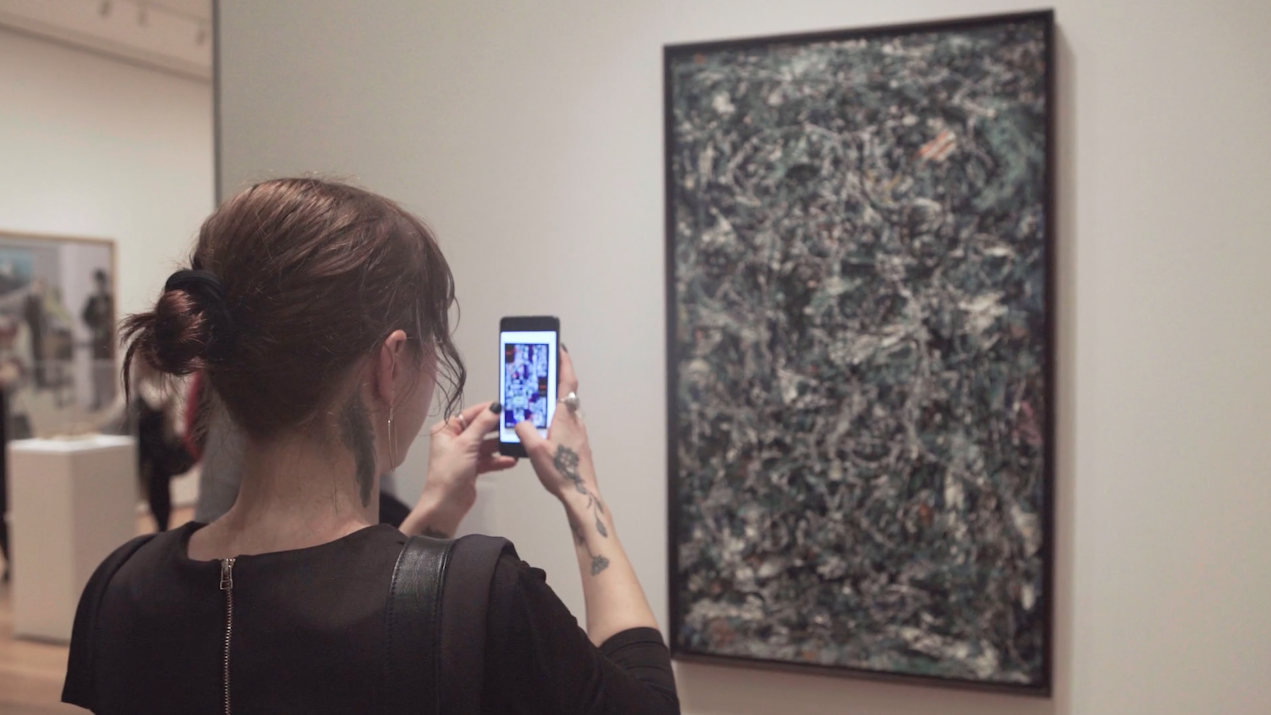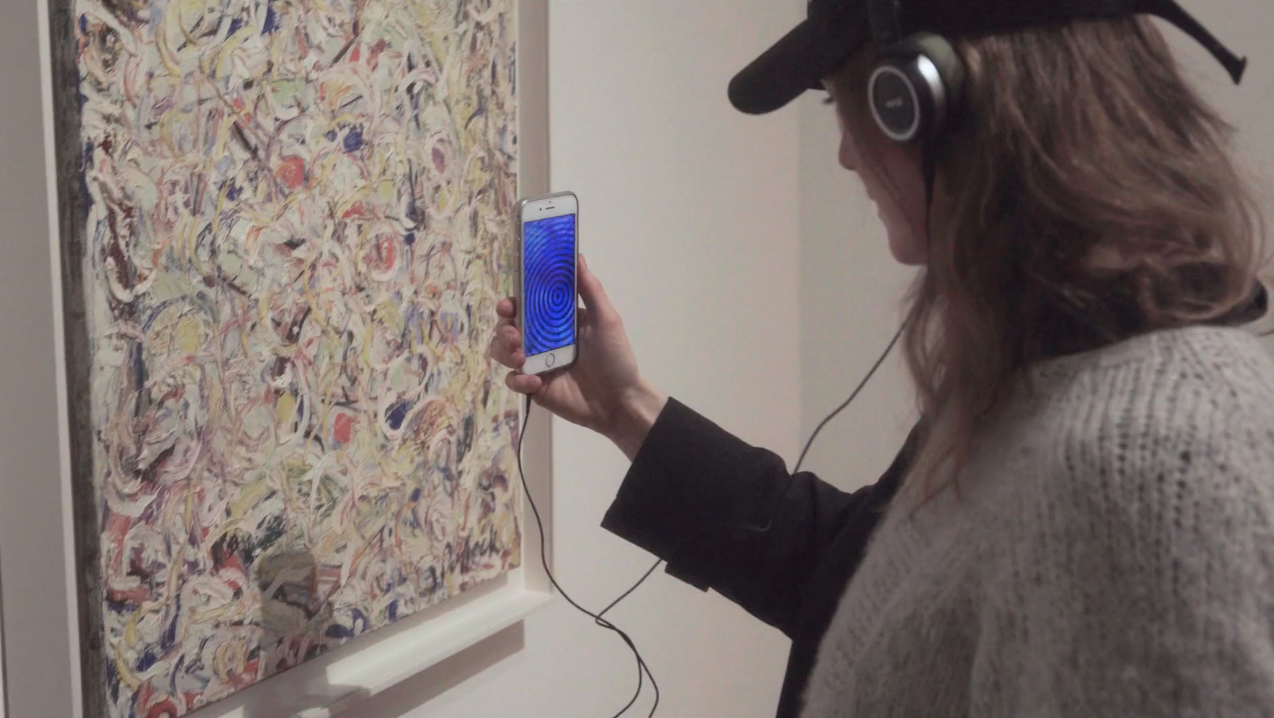The artist group developed an unauthorized AR app that lets you interact with Jackson Pollock’s paintings.
Digital artists David Lobser and Damjanski met at New Inc’s Versions conference and immediately began to collaborate on a new art project. The collaboration between the artists helped give rise to “Hello, we’re from the internet,” an interactive augmented reality (AR) exhibit that allows MOMA museum visitors to experience reinterpretations on top of Jackson Pollack’s art.
Eight artists ended up collaborating on the project as a collective, calling itself “MoMAR.”
“Damjanski has lots of really crazy conceptual projects, and when he mentioned MoMAR I was immediately hooked, as were all of the other artists we worked with,” Lobser said.
The group of artists chose the fifth floor Pollack exhibit at MOMA for the project because the room remain unchanged for so long. Lobser also said Pollack’s works “make for great AR markers because they are complex, high contrast and non-repeating.”
From now until May 6th, MOMA visitors can download the MoMAR app on Android or iOS and experience interactive 3-D extensions to Pollack’s art themselves. No permission needed.
The AR app uses Vuforia image recognition to scan and overlay new images onto the art. The project’s website describes it as “an unauthorized gallery concept aimed at democratizing physical exhibition spaces, museums, and the curation of art within them.”
The artists took different approaches to their overlays, creating a unique and eclectic mix of styles and interpretations. Some pieces interact directly with the original art and some don’t.
Artist Tara Sinn, who had collaborated with Lobser previously, created a piece called “Pregnant Pause,” which plays with concepts regarding representation of female bodies in art and Sinn’s “body of work” as a female artist.
“I’ve always viewed Jackson Pollock (and especially his process in making his paintings) as very masculine,” Sinn said. “So using one of his works as a backdrop for a piece about fertility and the idea of women as creators appealed to me.”
Scott Garner was also introduced to the team through his past collaboration with Lobser. He wanted to use the project as an avenue to tackle what he calls his “intense love/hate relationship with both museums and mid-century modern artists like Pollock.”
“My aim was to strip away all of the curatorial and historical fluff and look at Pollock’s work for what it objectively is—a giant mess on a perfectly good canvas,” he said.
In contrast to Garner and Sinn’s contradictory approach to Pollack, Gabe Barcia-Colombo’s interpretation reacts directly to the modern artist’s life and the work it interacts with.
“White Light Afterlife” is a gamified reinterpretation of one of Pollock’s last works which was made during a time when the painter “was tormented by an artistic block he would never overcome,” Barcia-Colombo said.
This torment is “represented here in the form of a game in which you fight off skeletons and the spinning wheel of death in order to achieve everlasting life as a human augmented reality image target.”
 Artist Sarah Rothberg’s project turns the frame of Pollock’s “Easter and the Totem” into a large interactive iPhone. You can create a video feedback loop or “like” the image or play audio of a poem Rothberg wrote that is affected by your physical distance from the painting. Her piece is called “It feels so good to touch your phone.”
Artist Sarah Rothberg’s project turns the frame of Pollock’s “Easter and the Totem” into a large interactive iPhone. You can create a video feedback loop or “like” the image or play audio of a poem Rothberg wrote that is affected by your physical distance from the painting. Her piece is called “It feels so good to touch your phone.”
“I thought about the modern experience of looking at art where in the back of your mind you can always be hijacked by the feeling of the internet beckoning,” she said.
This is not the first time AR has been incorporated into the MOMA. A 2010 exhibit called “WeARinMOMA” added various stand-alone 3-D AR pieces throughout the museum for those who downloaded the app. Similarly, the exhibition was not sanctioned by the museum, although the artists did attempt to reach out.
 All the MoMAR artists agree that reclaiming art spaces was an important part of this project. Barcia-Columbo enjoyed watching their project pack the Pollock room on the opening day of their exhibit, and wonders whether MOMA staff thought there is a sudden resurgence of passion for Pollock’s work.
All the MoMAR artists agree that reclaiming art spaces was an important part of this project. Barcia-Columbo enjoyed watching their project pack the Pollock room on the opening day of their exhibit, and wonders whether MOMA staff thought there is a sudden resurgence of passion for Pollock’s work.
“I loved the guerilla nature of holding an opening at Moma and watching people experience the interactive works as a new layer on top of Pollock,” he said.
For Lobser, the relationship between their project and the traditional gallery setting for which it was built was the most satisfying element of the collaboration.
“The contrast between our scrappy, hacky app and the most institutional of institutions was satisfying,” he said.
The post Artists Create AR Takeover at NYC’s Museum of Modern Art appeared first on VRScout.
from VRScout http://ift.tt/2ptJBra
via IFTTT
No comments:
Post a Comment